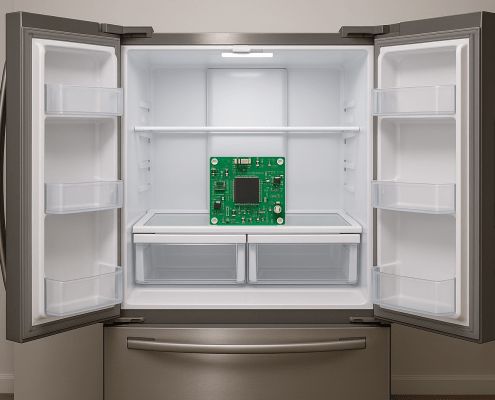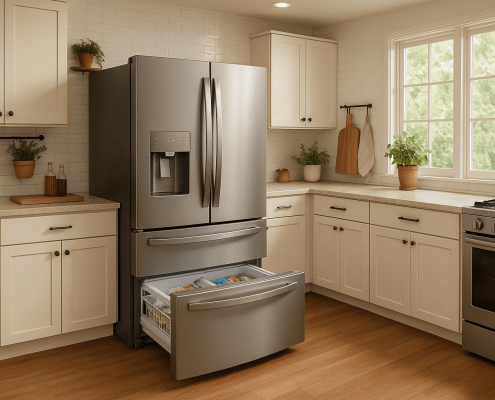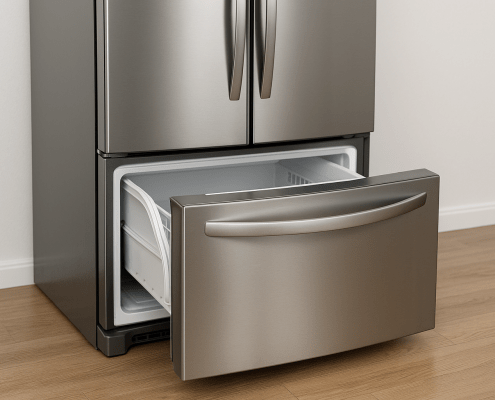Why Is My Refrigerator Sweating On The Outside? 7 Causes of Condensation & Moisture (With Video!)
APP Expert / Thursday June 17, 2021
Is your refrigerator sweating like it’s just run a marathon? This pesky moisture problem can turn your kitchen into a sticky mess and might point to a bigger issue lurking within your appliance. But don’t worry, our step-by-step guide and handy how-to video just below will help you quickly pinpoint and fix the cause, putting your fridge back in the cool zone.
There are a few different components on a refrigerator that can go bad and make the refrigerator sweat or have moisture on the outside. Troubleshooting these components will often offer insight into what is causing the problem. However, it’s essential to ensure you’re safe while going through the process. Turn off the water supply under the kitchen sink and ensure the refrigerator is unplugged or the circuit breaker has been turned off. Follow this easy guide to diagnose which part may be to blame for the refrigerator condensation.
What does it mean if my refrigerator is sweating?
Condensation, or sweating, is caused when warm and cold air mix. When this happens, moisture is drawn out of the warm air, creating water droplets on nearby surfaces. If you’re finding condensation on your refrigerator, it could mean a few different things:
- The temperature setting on your fridge is too low, making the air too cold.
- If it’s particularly hot or humid, your fridge may start to sweat, particularly if someone at home is opening and closing the refrigerator door a lot.
- It could mean that some part, like the door gasket, is faulty and creating an air leak that allows the cool air in the fridge to escape.
How do I stop condensation on the outside of my refrigerator?
Start by checking the refrigerator temperatures and turning them up a bit if they’re set particularly low. You may also want to deactivate the energy saver option on your fridge if it has one as this can cause sweating. If you’re still finding condensation on your fridge after that, a faulty part could be the culprit. Keeping reading, this guide will walk you through which parts to check and replace.
Once you have identified the part needed for your refrigerator, search below using your specific fridge model number to identify the exact part needed:
1. Door Closure Cams
When a refrigerator has moisture on the outside, the first thing to look at are the door closure cams. There are numerous issues that can occur if these are not working appropriately. These parts are provided for the door to ride on when it’s being opened or closed. While these come in many styles, most of them will be plastic and have a lower and upper cam. These cams have a smooth surface that the door rides on to open or close it easily.
If you have a refrigerator with door closure cams, you’ll find the upper one on the door and the lower one on the bottom door hinge. If these cams are damaged or cracked, the door opening may not stay sealed the way that it should when it’s closed. This can cause the refrigerator to sweat. If this is the problem, there is often a sound of plastic rubbing on plastic. Take a look at the door closure cams for any damage or wear and replace them if there is an issue.
2. Door Closure Levers and Cams
If the door closure cams are working the way they should be, the next thing to consider are the door closure levers and cams. While the cams help the doors open and close, the door closure levers and cams help with automatic closing and opening of the door. The closer will typically have a cam and lever that work in tandem, but they are sold on an individual basis.
The cam is most often going to be found on the door while the level is mounted on the cabinet of the refrigerator. Depending on the refrigerator, the cams and levers might be on the bottom or the top of the fridge. Working together, the levers and cams help hold the door open automatically and assist it with shutting when you want it to be closed. If these parts are not working correctly, they can cause a refrigerator to sweat.
Once you find the door closure levers and cams, take a look at them for any present damage. If these have failed, they are going to need to be replaced to alleviate the problem. After you reinstall new levers and cams, it should cause the door to work the way it should once the power and water are turned back on for the refrigerator.
3. Ice Dispenser Chute Door
The third component that might cause a sweating refrigerator is the ice dispenser chute door. If this part isn’t working, it can also lead to a buildup of frost in the refrigerator. On a refrigerator, the ice dispenser chute door is the part that lets ice come out of the dispenser. It can have many different looks based on the model of the refrigerator. It opens up to let ice out when it’s pressed but closes and seals when it is not. If it doesn’t properly seal, this can lead to refrigerator sweat.
You’ll find the chute door in the dispenser area of the refrigerator; most of the time it will be located behind the control panel. If the ice dispenser chute door is damaged or isn’t working correctly, it can start to cause problems. The best way to get access to the chute door is to take a putty knife or a small screwdriver and use it to remove the frame on the control panel. Once you have access to the door, look for damage and replace the part, if necessary.
4. Ice Dispenser Solenoid
If all of the previous components are working well, the next thing to inspect is the ice dispenser solenoid. This part is made to open and close the door to the ice chute. The solenoid is a tiny component that opens and closes the chute so that ice can come through into a glass. It is made up of a plunger that is located on the door arm and a coil with terminals.
If there is an ice dispenser solenoid on the refrigerator, it’s going to be located in the refrigerator’s ice dispenser area. Most of the time, it will be found behind the control panel. If this part has stopped working, it can result in causing a refrigerator to sweat. Take a putty knife or a small screwdriver and remove the control panel frame. This will give you access to the solenoid.
Once you have found the ice dispenser solenoid, the wires must be removed or the wiring harness must be disconnected to continue the testing process. If the solenoid has a wiring harness, use a multimeter probe to reach into each side to test the device for continuity. If the solenoid has wires instead, the probes of the multimeter should be used on the two terminals. If there is no continuity reading, the ice dispenser solenoid will need to be replaced.
5. Dispenser Door Spring
The dispenser door spring is another part that can cause your refrigerator to start sweating. This part, which is also known as a door recess spring, is used in the refrigerator to put the ice door into the closed position or take the dispenser level to the home position when it’s released. In most refrigerators, this part is going to be found inside of the water dispenser assembly, which is behind the main control panel.
This component needs to be inspected to determine if it has gone bad. In order to release the spring, you’ll want to take a putty knife or a small screwdriver and use it to pry off the housing for the dispenser so you can get access to it. If this part is damaged or is no longer working, it can contribute to a refrigerator that is sweating. However, repairing this component is simple and will only take a few minutes.
If the door doesn’t seal and ice builds up in this area, take the dispenser apart first. The drip tray will need to be removed first and can be put aside. Next, the top funnel can be removed from the dispenser using the locking tabs that may be found on the front and back of the refrigerator. Take a small screwdriver and place it in the housing to make the tabs come loose. Once the funnel has been removed, the dispenser front can be removed using a screwdriver, being careful not to scratch it. Do each side and then move on to taking off the frame and rotating it. Press the locking mechanism to remove the wires that are connected. A screwdriver can be used to remove the plate on the front of the dispenser. Pull it out and access the ice chute door, which can be taken out. Next, lower down the door and take off the ice door lever spring. At this point, the new component can be installed into the refrigerator, which should prevent the refrigerator from sweating.
6. Door Gaskets
Another component that can go bad and lead to the sweating refrigerator are the door gaskets. These work together to seal the refrigerator doors so cool air gets in and warm air stays outside. In many cases, the door gaskets will have one side that is flat and magnetic while the other side is ribbed to make it easier to mount on the refrigerator. Door gaskets can be found along the outer area of the door and can cause sweating if they are malfunctioning, dirty, or deformed. If those problems are found, testing and cleaning will need to be done before deciding whether the door gasket needs to be replaced with a new part.
Visually inspect the door gaskets and clean them off as much as possible. If you leave the door open during the process, that will make it easier to do. While you’re cleaning things up, make sure to watch for deformities and damage. Most of the time, these problems will be found on the hinge side of the door. If the deformities are minor, a hairdryer might be capable of fixing the problem. However, a more significant problem or a failed magnet points to the need to replace the door gasket.
7. Mullion Heater
The last component to check when a refrigerator has moisture on the outside is the mullion heater. Also known as an anti-sweat heater, these are located in the face of the refrigerator’s frame. They prevent moisture from forming on the outside of the refrigerator. If your refrigerator has a mullion heater, it may be malfunctioning and causing the refrigerator to sweat.
If you inspect the mullion heater and the door gaskets, you may notice sweating nearby. In this case, the mullion heater will typically need to be replaced. The first step is to remove the refrigerator door and locate the mullion heater. Pull the heater toward you and use the appropriate socket to remove it from the door. Lift it up and out of the door before disconnecting the wire connector. Next, take the new mullion heater and install it into the refrigerator. At this point, you can test the fridge.
Where To Find Us
Still have questions after reading this guide? Please reach out to AppliancePartsPros.com, we are always happy to help you fix your appliance yourself. Since 1999, AppliancePartsPros.com has helped millions of people repair their broken appliances by providing high-quality original parts at well below retail prices, free tech support and troubleshooting, and award-winning customer service! Visit our site at https://www.appliancepartspros.com or call us at 877-477-7278. Over 90% of orders delivered in 1-2 days with guaranteed overnight shipping available! 365 days to return any part. Expert, friendly, US-based customer support team.
Hi! I’m Matt H., and I’m thrilled to be your guide through the world of appliance repair with over 25 years of invaluable experience in the industry.
From the early days of my career, I have been deeply passionate about appliances and their inner workings. Over the years, I’ve seen it all – from vintage models to the latest cutting-edge technology – and I’ve dedicated myself to mastering the art of repair. With a toolbox in one hand and a wealth of knowledge in the other, I’ve tackled every challenge that has come my way, learning and growing with each repair.
Join me as we dive into the intricacies of appliance repair. From step-by-step repair guides to explanations of common problems and their solutions, I’ll be here to simplify the repair process and empower you with the knowledge you need to keep your appliances running smoothly.
Feel free to explore our blog, ask questions, and leave comments – this platform is a space for learning, sharing, and growing together. Let’s work together to ensure that your appliances continue to serve you for years to come.
Thank you for joining me on this journey, and I look forward to being your go-to resource for all things related to appliance repair!





